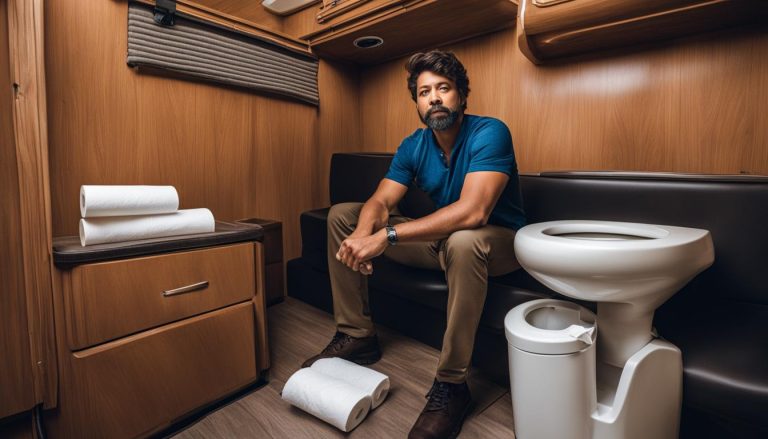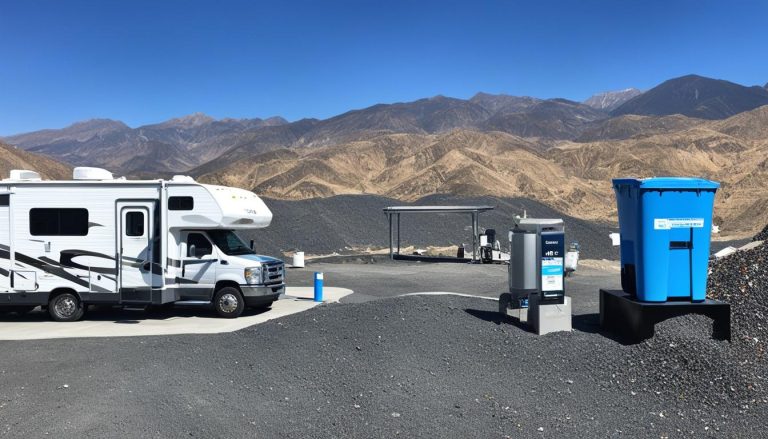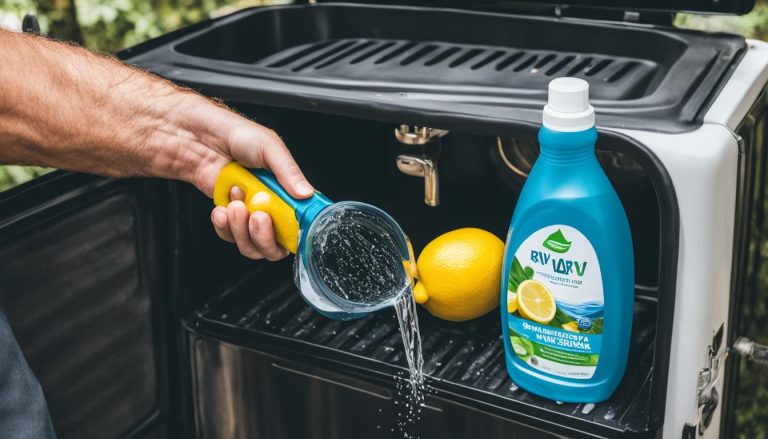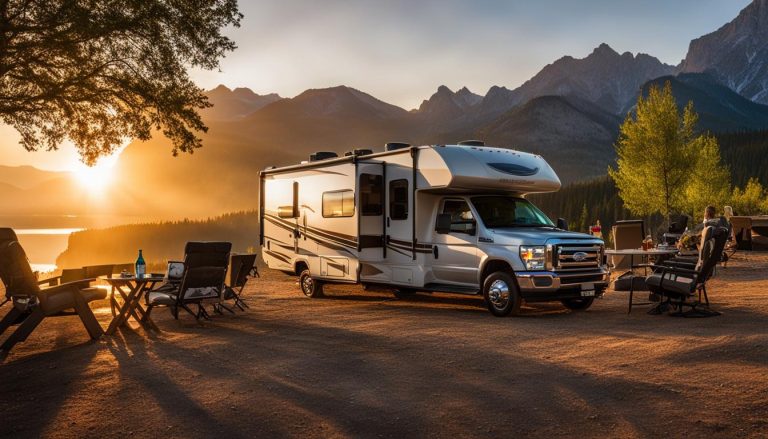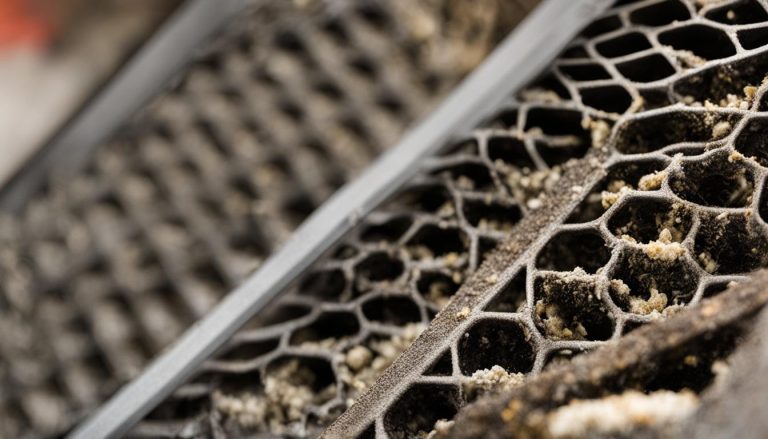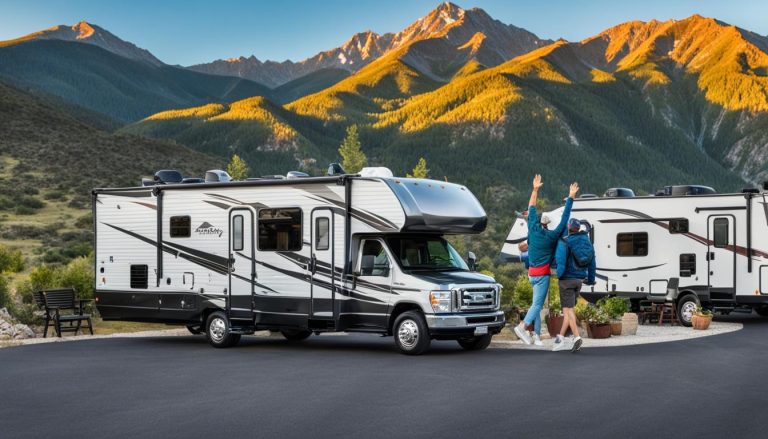Ensure Your RV Water Tank is Pure & Safe
gorvlifestyle.com and its partners may earn a commission if you purchase a product through one of our links
When it comes to enjoying your camping adventures in an RV, having access to clean and safe water is essential. The RV’s fresh water tank is responsible for providing water for drinking, showering, and washing dishes, so it’s crucial to ensure that it remains pure and free from contaminants. Regular maintenance and proper purification methods are key to achieving this.
To start, regular cleaning and sanitization of the RV water tank are necessary to keep the water in it clean and safe. This can be done using bleach or eco-friendly cleaning solutions. By following a simple process of draining the tank, adding the appropriate bleach mixture, and allowing it to circulate throughout the system, you can effectively eliminate any harmful elements that may be present.
Maintaining your RV water tank is equally important. Regular inspections for leaks or damage, as well as proper storage during freezing temperatures, can help prevent issues and ensure the longevity of your tank. By taking these preventive measures and adopting good maintenance habits, you can have peace of mind knowing that your RV water tank is in excellent condition.
Key Takeaways:
- Regularly clean and sanitize your RV water tank to ensure the water remains pure and safe for use.
- Use bleach or eco-friendly cleaning solutions to eliminate contaminants in your RV water tank.
- Maintain your RV water tank by conducting regular inspections for leaks and damages.
- Properly store your RV water tank during freezing temperatures to prevent damage.
- Adopt good maintenance habits to ensure the longevity of your RV water tank.
How to Sanitize Your RV Fresh Water Tank
It is crucial to keep your RV’s fresh water tank clean and sanitized to ensure a safe water supply for drinking, showering, dishwashing, and laundry on the road. Regular sanitization is recommended at least once a year, preferably during the spring when dewinterizing the RV. Some RVers also perform this task every time their RV has sat unused for 2-4 weeks. By following these steps, you can effectively sanitize your RV’s fresh water tank:
- Turn off the water heater and water pump.
- Drain the entire fresh water tank.
- Calculate the amount of bleach needed based on the tank’s capacity. As a general guideline, use 1/4 cup of bleach for every 15 gallons of tank capacity.
- Dilute the bleach in a gallon of water to create a bleach mixture.
- Add the bleach mixture to the fresh water tank.
- Fill the tank with potable water until it is full.
- Run the water pump to circulate the bleach solution throughout the RV’s plumbing system.
- Let the bleach solution sit in the tank and plumbing system for 12-24 hours to disinfect.
- Drain the tank and flush the system by running fresh water through all faucets, showers, and toilets until no bleach smell is present.
Remember to dispose of the bleach solution properly and avoid using the RV’s water system during the sanitization process. Additionally, always refer to your RV’s owner’s manual for specific instructions and guidelines regarding tank sanitization.
By regularly sanitizing your RV’s fresh water tank using these simple steps, you can ensure clean and safe water for all your onboard needs.
Using Huwa-San for RV Water Treatment
When it comes to ensuring the cleanliness and safety of your RV’s freshwater holding tanks and plumbing systems, Huwa-San Peroxide is the solution you need. Manufactured by Roam Technology in Belgium, Huwa-San Peroxide is a stabilized hydrogen peroxide solution specifically designed for RV water treatment. It effectively eliminates viruses, bacteria, fungi, and algae, providing you with clean and safe water during your travels.
Unlike bleach-based products, Huwa-San Peroxide does not produce toxic or harmful by-products. It breaks down into water and oxygen, leaving no residues or chemicals behind. This makes it a more environmentally-friendly option for RV water disinfection.
Using Huwa-San Peroxide for RV water treatment is simple and convenient. Just add the appropriate amount of Huwa-San Peroxide to your freshwater tank before filling it with water. The stabilized formula ensures that the treatment remains effective for extended periods, even in varying temperatures. To ensure proper treatment, Huwa-San Peroxide comes with hydrogen peroxide testing strips.
With Huwa-San Peroxide, you can have peace of mind knowing that your RV’s water is disinfected and safe for all your needs. Say goodbye to contaminants and enjoy clean, fresh water throughout your travels.
| Treatment Benefits | Huwa-San Peroxide | Bleach-based Products |
|---|---|---|
| Eliminates bacteria, viruses, fungi, and algae | ✔ | ✘ |
| Leaves no toxic or harmful residues | ✔ | ✘ |
| Environmentally-friendly | ✔ | ✘ |
| Stabilized formula for long-lasting effectiveness | ✔ | ✘ |
| Easy to use | ✔ | ✘ |
Testimonials
“I’ve been using Huwa-San Peroxide for my RV water treatment, and I couldn’t be happier. It’s effective, easy to use, and gives me peace of mind knowing that my water is clean and safe. Highly recommend!”
– Jane Smith, RV enthusiast
“Huwa-San Peroxide has been a game-changer for us. It’s so much better than using bleach. Our water tastes great, and we feel confident in the quality. Definitely worth it!”
– John Doe, experienced RVer
In Summary
When it comes to RV water treatment, Huwa-San Peroxide offers a safe, efficient, and environmentally-friendly solution. By using Huwa-San Peroxide, you can ensure that your RV’s freshwater holding tanks and plumbing systems are free from harmful contaminants. Enjoy clean and safe water wherever your travels take you.
Ensuring Clean Drinking Water in Your RV
Drinking clean water while on the road is essential for your health and comfort in your RV. By following a few simple steps and using the right equipment, you can ensure the cleanliness and safety of the water in your RV’s plumbing system.
Use a Dedicated Drinking Water Hose
When filling your RV’s water tank, make sure to use a dedicated drinking water hose that is white or blue in color. These hoses are specifically designed for potable water and help prevent cross-contamination. Using a designated hose ensures that your water supply remains clean and free from any potential contaminants.
Proper Storage of the Drinking Water Hose
When not in use, it’s important to store your drinking water hose properly to prevent dirt and contaminants from entering the hose. Store it in a clean and dry area, away from any potential sources of contamination. This will help maintain the integrity and cleanliness of the hose, ensuring that your water remains safe for drinking.
Regularly Sanitize Your RV’s Water System
To maintain the cleanliness and quality of your RV’s water system, it’s crucial to sanitize it regularly. Use a sanitizing product, such as bleach or other sanitizers recommended by the manufacturer, to eliminate bacteria and maintain water quality. Follow the instructions provided by the product for the proper dilution and application. By sanitizing your RV’s water system, you can ensure that the water you drink is safe and free from harmful bacteria.
Invest in RV Water Filters
Using water filters specifically designed for RVs can further enhance the taste and quality of the water in your RV. These filters are designed to remove impurities and contaminants, providing you with clean and refreshing drinking water. It’s important to follow the manufacturer’s recommendations for maintenance and replacement to ensure optimal performance.
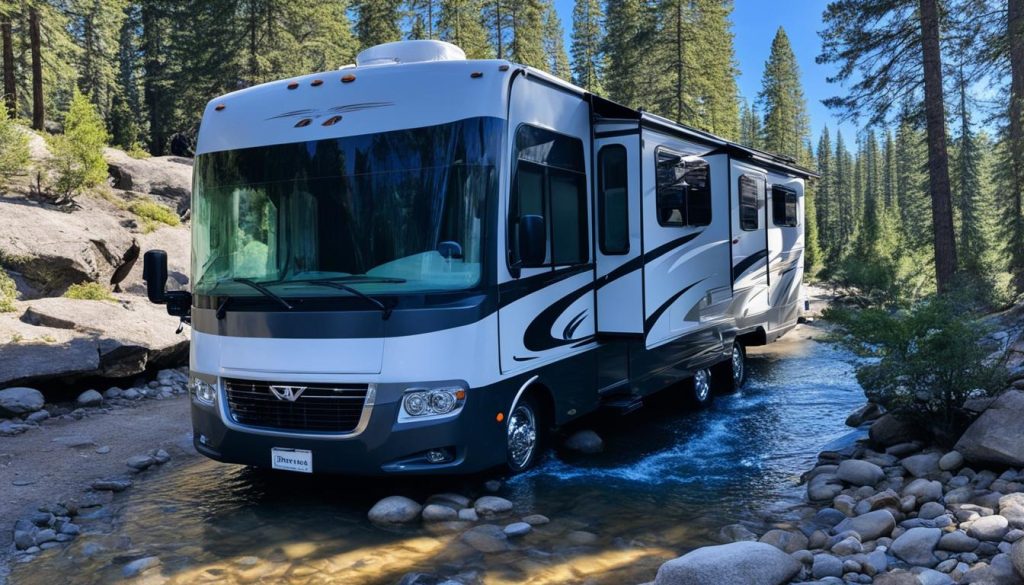
By implementing these practices, you can enjoy clean and safe drinking water in your RV. Investing in the right equipment and following proper maintenance procedures will ensure that you and your family stay hydrated and healthy throughout your RVing adventures.
Tips for Clean Drinking Water on the Road
When traveling in your RV, it’s crucial to have a continuous supply of clean drinking water. To ensure this, consider carrying a portable water purification method, such as water purification tablets or a water filter bottle, especially for emergencies or situations where potable water is not readily available. These compact and convenient solutions effectively remove contaminants, providing you with safe drinking water wherever you go.
In addition to ensuring clean water, conserving water while RVing is equally important. By practicing water conservation techniques, you can reduce the strain on your fresh water tank and have enough water for drinking, cooking, and other essential needs. Simple tips like taking shorter showers, turning off the faucet while brushing your teeth, and using dishwashing methods that minimize water usage can go a long way in conserving this precious resource.
By adopting these practices, you can have peace of mind knowing that you have access to clean and safe drinking water throughout your RV travels. Whether you’re exploring national parks or embarking on a cross-country adventure, these tips for clean drinking water and water conservation will ensure a refreshing and sustainable RV journey.
FAQ
How often should I sanitize my RV’s fresh water tank?
It is recommended to sanitize your RV’s fresh water tank at least once a year, usually in the spring when dewinterizing the RV. Some RVers also perform this task every time their RV has sat unused for 2-4 weeks.
What is Huwa-San and how does it work?
Huwa-San Peroxide is a stabilized hydrogen peroxide solution designed specifically for the safe and efficient disinfection and treatment of RV freshwater holding tanks and plumbing systems. It eliminates viruses, bacteria, fungi, and algae, ensuring that the water stored in the RV’s tanks remains clean and safe. Unlike bleach-based products, Huwa-San does not create toxic or harmful by-products and leaves behind only water and oxygen.
How do I ensure clean drinking water in my RV?
To ensure clean drinking water in your RV, use a dedicated drinking water hose that is white or blue in color to prevent cross-contamination. Sanitize your RV’s water system regularly with bleach or other sanitizing products to eliminate bacteria. Consider using water filters designed for RVs to improve the taste and quality of the water.
How can I conserve water while RVing?
To conserve water while RVing, take shorter showers, turn off the faucet while brushing your teeth, and use dishwashing methods that minimize water usage. Conserving water reduces the strain on your fresh water tank and ensures you have enough water for essential needs.
What are some portable water purification methods for RV travel?
For emergencies or situations where potable water is not readily available, you can carry water purification tablets or a water filter bottle. These portable methods can help ensure a continuous supply of clean drinking water during your RV travels.

